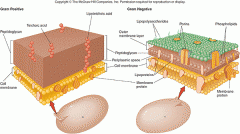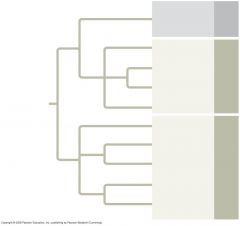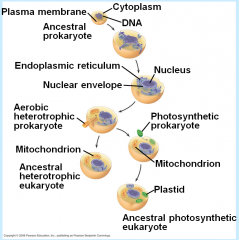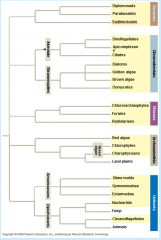![]()
![]()
![]()
Use LEFT and RIGHT arrow keys to navigate between flashcards;
Use UP and DOWN arrow keys to flip the card;
H to show hint;
A reads text to speech;
95 Cards in this Set
- Front
- Back
|
Prokaryotic Cells
|
- no membrane bound oragnelles
- a lot smaller compared to eukaryotes |
|
|
Bacteria
|
- prokaryote
- constitute a large domain of prokaryotic microorganisms - contains peptidoglycan in cell wall |
|
|
Archaea
|
- prokaryote
- single celled microorganism - does not have a usual cell wall - does not contain peptidoglycan in cell wall - some species can live in extreme environments |
|
|
Prokaryote that inhabits (lives) in the Great Salt Lake in Utah.
|
Halobacterium (genus)
|
|
|
The most common shapes or prokaryotes
|
- Spherical (cocci)
- Rod-shaped ( Bacilli) - spiral ( spirilla) |
|
|
cell surface structures
|
- cell wall of prokaryotes differ from eukaryotes in terms of structure
|
|
|
Eukaryote Cell wall structure (plants and fungi)
|
- made from cellulose or CHITIN
|
|
|
Most Bacterial cell walls contain
|
- Peptidoglycan
|
|
|
Peptidoglycan
|
- polymer composed of modified sugar crossed-linked by short polypeptides
- encloses the entire bacterium and anchors other molecules that extend from its surface |
|
|
Archaeal cell wall
|
- does not have peptidoglycan
- contains a variety of polysacchrides and proteins |
|
|
Gram staining
|
- quickly determining if cell is gram negative or positive
- developed by a Danish physician Hans Christian Gram - If stain stays, bacteria is Gram positive. If the stain doesn't stay, it is gram negative. |
|
|
Gram positive
|
- the stain stays
- have simpler cell walls - contain a large amount of peptidoglycan |
|
|
Gram negative
|
- has less peptidoglycan
- structurally more complex - outer layer contains lipopolysacchrides - lipid portion of lipopolysacchride are toxic, causing fever or shock -impedes entry of drugs due to the outer due to the outer membrane (more resistant to drugs |
|
|
lipopolusacchrides
|
carbohydrates bonded to lipids
|
|
|
penicillin
|
- attacks cell wall of bacteria
- inhibits peptidoglycan cross linking - resulting cell wall may not be functional specially in gram positive bacterias |
|
|
Gram positive and negative (picture)
|

|
|
|
cell wall of prokaryotes
|
- many are surrounded by a layer of polysacchrides or protien
- capsule - slime layer |
|
|
capsule
|
- dense, well defined layer of polysacchride or protien layer present in most prokaryotes
|
|
|
slime layer
|
- less well organized version of the capsule
|
|
|
Both capsule and slime layer
|
- enables prokaryotes to adhere to their substrate or to other individuals in a colony
- some protect against dehydration - some shield pathogenic prokaryotes from attacks by their host's immune system |
|
|
pili (sex pili)
|
- longer than fimbriae
- allow prokaryote to exchange DNA |
|
|
Fimbriae (attachment pili)
|
- hairlike appendages used by some prokaryotes to stick to their substrate or to one another
- shorter than pili |
|
|
taxis
|
- almost half of all prokaryotes are capable off
- a directed movement toward or away from a stimulus - cells may use flagella as a motility structure |
|
|
prokaryotes
|
- DNA is circular
- no membrane bound oraganelle - much smaller compared to eukaryotes - evolve/ reproduce quickly (short generation time) by binary fission (1-3 hours) - asexual - chormosome is located in the nucleoid |
|
|
eukaryotic cell
|
- have memrbrane bound organelles
- linear DNA |
|
|
plasmids
|
- much smaller rings of independently replicating DNA molecules, carrying only a few genes
|
|
|
binary fission
|
- a single cell divides into 2
- exponential - prokaryotes can divide within 1-3 hours - some can produce a new generation within 20 minutes |
|
|
endospore
|
- is a dormant, tough, and non-reproductive structure produced by certain bacteria
- triggered by a lack of nutrients, and usually occurs in Gram-positive bacteria - Endospores enable bacteria to lie dormant for extended periods, even centuries |
|
|
Obligate Aerobe
|
- cannot live withour oxygen
- require oxygen for cellular respiration |
|
|
Obligate anaerobe
|
- poisoned by oxygen
- use fermintation or anaerobic respiration |
|
|
Facultive anaerobes
|
- can survive with or without oxygen
- grows better with oxygen |
|
|
Nitrogen
|
- essential for the production of amino acids and nucleic acids in all organisms
|
|
|
Nitrogen Fixation
|
- conversion of nitrogen to ammonia
|
|
|
Nitrogen fixation
|
- prokaryotes can metabolize Nitrogen in a wide variety of forms
- some archaea (cyanobacteria/ methanogens), convert atmospheric nitrogen to ammonia |
|
|
nitrogen-fixing prokaryotes
|
- can increase the nitrogen available for plants which cannot use atmospheric nitrogen but can use the nitrogen compounds from ammonia
|
|
|
Metabolic Cooperation
|
cooperation between prokaryotic cells that allow them to use environmental resources they could not use as individual cells.
|
|
|
heterocysts
|
- specialized cells that carry out only nitrogen fixation
|
|
|
Biofilms
|
- surface coating colonies where metabolic cooperation between different prokaryotic species occur.
- cells in a biofilm secrete signaling molecules that recriut nearby cells, causing the colonies to grow |
|
|
Archaea
|
share certain traits with bacteria and other traits with eukaryotes
|
|
|
extemophiles
|
- live in extreme environments
- "lovers" of extreme conditions - extreme halophiles - extreme thermophiles |
|
|
extreme halophiles
|
- live in highly saline environments (salty) (Great Salt Lake and the Dead Sea)
- ex. is a Halobacterium |
|
|
extreme thermophiles
|
- Thrive in very hot environments
- ex. is Sulfolobus, lives in sulfur rich volcanic springs as hot as 90C. temperatures this high prevents the DNA of most organism from being a double helix. |
|
|
methanogens
|
- produce methane
- anaerobes - arhaea that live in moderate environments |
|
|
chemical reycling
|
.
|
|
|
decomposers
|
- chemoheterotrophic prokaryote function as a decomposer
- breaking down of dead organisms as well as waste products and thereby unlocking supplies of carbon, nitrogen, and other elements. |
|
|
Ecological Interactions
|
-prokaryotes play a central role in many ecological interactions
|
|
|
Symbiosis
|
an ecological relationship in which two species live in close contact with each other
|
|
|
host
|
larger organism in a symbiotic relationship
|
|
|
symbiont
|
smaller organism in a symbiotic relationship
|
|
|
mutualism
|
An ecological interaction between two species in which both benefit
|
|
|
commensalism
|
an ecological relationship in which one species benefits while the other is not harmed or helped in any significant way
|
|
|
parasitism
|
- an ecological relationship in which a parasite eats the cell contents, tissues, or body fluids of its host.
- as a group, parasites harm but does not usually kill their host |
|
|
pathogens
|
parasites that cause disease, many of which are prokaryotes
|
|
|
Exotoxins
|
- proteins secreted by certain bacteria and other organisms
|
|
|
Endotoxins
|
- lypopolusacchride components of the outer membrane of gram negative bacteria.
- endotoxins are only released when the bacteria die and their cell walls breakdown. |
|
|
metabollic diversity of prokartyoes
|
-Autotroph ( photoautotroph and chemoautotroph)
- Heterotroph (photoheterotroph and chemoheterotroph ) |
|
|
autotroph
|
- Photoautotroph
- Chemoautotroph |
|
|
Photoautotroph
|
- Energy source is Light\
- Carbon source is Carbon Dioxide\ - Photosynthetic prokaryote (cyanobacteria)( eg. protist (algae)) |
|
|
Chemoautotroph
|
- Energy source are Inorganic chemicals
- Carbon source is Carbon Dioxide - eg. Sulfolobus |
|
|
Heterotroph
|
- Photoheterotroph
- Chemoheterotroph |
|
|
Photoheterotroph
|
- Energy source is Light
- Carbon source are Organic compounds - eg. of organism- certain prokaryotes such as Rhodobacter |
|
|
Chemoheterotroph
|
- Energy source are organic compounds
- carbon source are organic compounds - eg. of organism - many prokaryote and protists ( fungi, animals and some plants |
|
|
Molecular systematics
|
:D
|
|
|
Universal ancestor
|

|
|
|
Polymerase chain reaction (PCR)
|
- allowed for more rapid sequencing of prokaryote genomes
- a handful of soil may contain 10,000 prokaryotic species - Horizontal gene transfer (HGT) between prokaryotes obscures the root of the tree of life |
|
|
Prokaryotes in Research and Technology
|
HAHAHA
|
|
|
Experiments using prokaryotes
|
Have led to important advances in DNA technology
|
|
|
Bioremediation
|
- the use of organisms to remove pollutants from the environment
|
|
|
Some uses of prokaryotes
|
- Recovery of metals from ores
- Synthesis of vitamins - Production of antibiotics, hormones, and other products |
|
|
Hypothesis of the origin of eukaryotes
|
MUAHGAHAHAH
|
|
|
oldest fossil of Eukaryote
|
- oldest fossil date back to 2.1 billion years
|
|
|
Hypothesis of endosymbiosis
|
- proposes that mitochondria and plastids ( chloroplasts) were formerly small prokaryotes living within larger host cells
|
|
|
endosysmbiont
|
a cell that lives within a host cell
|
|
|
Serial endosymbiosis
|
- supposes that mitochondria evolved before plastids through a sequence of endosymbiotic events
|
|
|
Endosymbiosis in Eukaryotic Evolution
|

|
|
|
Endosymbiosis in Eukaryotic Evolution ( The way Guppy likes it ;) )
|
1. Large prokaryote's plasma membrane infolds. Large prokaryote turns into a "primitive heterotrophic eukaryotic cell".
2. Primitive heterotrophic eukaryotic cell, swallows a "heterotrophic aerobic free living prokayote". For some reason, the Large eukaryote doesn't digest it, forming a symbiotic relationship over time. Turns into mitochondria. The large eukartyotic cell turns into a " Large heterotrophic Eurkaryotic cell". 3. "LHEC", engulfs an autotroph (photosynthetic prokaryote). Does not digest it, and over time forms a symbiotic relationship. The prokaryote turns into a plastid (eg. chloroplast) 4. Later evolved to be either a Heterotrophic protist or a autotrophic protist. |
|
|
Mitochondria
|
evolved by endosymbiosis of an aerobic prokaryote
|
|
|
Plastid
|
evolved by endosymbiosis of a photosynthetic cyanobacterium
|
|
|
Key evidence supporting an endosymbiotic origin of mitochondria and plastids:
|
- Similarities in inner membrane structures and functions
- Division is similar in these organelles and some prokaryotes - These organelles transcribe and translate their own DNA - Their ribosomes are more similar to prokaryotic than eukaryotic ribosomes |
|
|
Protist
|
- the informal name of the kingdom of mostly unicellular eukaryotes
- eukaryotes - some are colonial and multicellular species - more structural and functional diversity than any other eukaryotes - can be very complex - can reproduce sexually or asexually |
|
|
Nutritional forms of Protista
|
- photoautotroph
- heterotroph - mixotroph |
|
|
photoautotroph
|
- contain chloroplast
|
|
|
heterotroph
|
- absorb organic molecules or ingest larger food particles
|
|
|
mixotroph
|
- combine photosynthesis and heterotrophic nutrition
|
|
|
Five Supergroups of Eukaryotes
|

|
|
|
It is believed that animal and fungal cells
|
arose from ancestral protists that did not engulf cyanobacteria (photosynthetic prokaryote) after mitochondria, therefore, remained heterotrophic
|
|
|
Plants may have arisen
|
from photosynthetic protists containing plastids
|
|
|
Protista
|
- live in a aquatic or damp environments (ponds, lakes, and oceans)
|
|
|
Amoeba and paranecium
|
- unicellular heterotrophic protists
- amoeba by extension of their cytoplasm in pseudopods and engufs food particles - paramecia move by beating of cillia |
|
|
Photosynthetic protists such as EUGLENA
|
- found in fresh water enviroments and move by use of flagellum.
- contains chloroplast, therefore, it can make its own food |
|
|
slime molds and water molds
|
- colonial heterotrophic protists
- involved in decomposition of organic materials - slime molds are clumps of amoeba like cells - often found on rotting logs |
|
|
Algae
|
- mainly multicellular protists
- photosynthetic - 3 main groups: Chlorophyta, Phaeophyta, Rhodophyta |
|
|
Chlorophyta
|
- green algae
- unicellular -most abundant and contain chlorophyl a and b. - store food as starch in plastid - have a cellulose wall, closely related to plants |
|
|
Phaeophyta
|
- brown algae
- almost exclusively marine - have chlorophyl a and c |
|
|
Rhodophyta
|
- red algae
- contain chlorophyll a and some have chlorophyll d - accessory pigment that give them their reddish colour - found in deeper dephts than the chlorophyta and phaetophyta |

